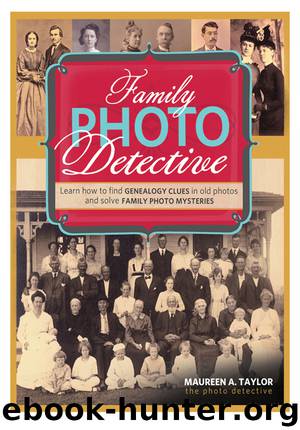Family Photo Detective by Maureen A. Taylor

Author:Maureen A. Taylor [Taylor, Maureen A.]
Language: eng
Format: epub
ISBN: 978-1-4403-2502-1
Publisher: F+W Media
Published: 2013-12-03T05:00:00+00:00
Grant Emison
Use caution when comparing facial characteristics: a person’s face changes over time.
Family Resemblances
Probably the most difficult technique involved in photo identification is identifying and grouping people by facial characteristics. In some families, there may be a distinguishing characteristic, such as a mole that appears in a particular part of the face in several family members, or a distinctive shape of the eyes or nose. Hopefully your collection of photographs contains some identified images, so that you can begin to group them by family facial attributes.
Criminal investigators use facial characteristics to identify suspects, and you can use some of their techniques to try to identify people in family photographs. Police identification specialists use a standard list of characteristics to help create a composite. You will be attempting to do just that. Inspect the faces in your photographs and create a table of unique aspects to look for.
Trace a photocopy of a family portrait, reduce it to the scale of the photo you are trying to identify, and compare jaws, ears, and facial shape. This can also be done by scanning an image and manipulating it using photo-editing software. Be careful with this method of identification, though—a person’s face changes with age and weight tends to fluctuate.
Lay your identified family photos out in a timeline for each person. Compare your unidentified images to the timelines. Noticing similar noses, eyes, or cheekbones can establish a family connection. Those images that defy identification will require further research.
When you create your photographic timeline, use photocopies of the images so you can retain the layout of the collection as arranged by the original owner. Re-examining the photographs in the context in which they were given to you can also help to identify individuals.
Physical Characteristics to Examine
In particular, it is helpful to look at:
Shape of face: oval, heart shaped, round, square
Eyes (shape, position, color, size)
Nose and nostrils (shape, size)
Ears (shape, size, position on head, length)
Hair pattern (baldness, widow’s peaks)
Eyebrows (size, shape)
Moles
Teeth
Download
This site does not store any files on its server. We only index and link to content provided by other sites. Please contact the content providers to delete copyright contents if any and email us, we'll remove relevant links or contents immediately.
Twilight of the Idols With the Antichrist and Ecce Homo by Friedrich Nietzsche(18299)
CHERUB: The Recruit by Robert Muchamore(2151)
CHERUB: The Fall by Robert Muchamore(1985)
I Capture the Castle by Dodie Smith(1904)
CHERUB: Man vs Beast by Robert Muchamore(1883)
The Edge of the Abyss (Sequel to The Abyss Surrounds Us)(1710)
Black Genesis by Robert Bauval(1530)
all by Unknown Author(1494)
A Brief History of Everyone Who Ever Lived by Adam Rutherford(1462)
Where Do I Start? by Chase Taylor Hackett(1227)
Spook Street (Slough House) by Mick Herron(1177)
2016 Baby Names Almanac(1165)
How to Argue With a Racist by Adam Rutherford(1133)
Painfully Rich by John Pearson(1124)
Genetics by Adam Rutherford(1113)
2011 Baby Names Almanac(1037)
Black Hawk Down by Mark Bowden(1034)
Life After Life: A Novel by Kate Atkinson(1016)
It's All Relative by A. J. Jacobs(1004)
